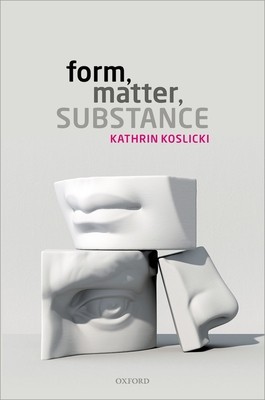
- We will send in 10–14 business days.
- Author: Kathrin Koslicki
- Publisher: Oxford University Press, USA
- ISBN-10: 0198823800
- ISBN-13: 9780198823803
- Format: 15.8 x 23.6 x 2.3 cm, kieti viršeliai
- Language: English
- SAVE -10% with code: EXTRA
Reviews
Description
In Form, Matter, Substance, Kathrin Koslicki develops a contemporary defense of the Aristotelian doctrine of hylomorphism. According to this approach, objects are compounds of matter (hule) and form (morphe or eidos) and a living organism is not exhausted by the body, cells, organs, tissue and the like that compose it. Koslicki argues that a hylomorphic analysis of concrete particular objects is well equipped to compete with alternative approaches when measured against a wide range of criteria of success. However, a plausible application of the doctrine of hylomorphism to the special case of concrete particular objects hinges on how hylomorphists conceive of the matter composing a concrete particular object, its form, and the hylomorphic relations which hold between a matter-form compound, its matter and its form. Koslicki offers detailed answers these questions surrounding a hylomorphic approach to the metaphysics of concrete particular objects. As a result, matter-form
compounds emerge as occupying the privileged ontological status traditionally associated with substances due to their high degree of unity.
EXTRA 10 % discount with code: EXTRA
The promotion ends in 23d.09:03:57
The discount code is valid when purchasing from 10 €. Discounts do not stack.
- Author: Kathrin Koslicki
- Publisher: Oxford University Press, USA
- ISBN-10: 0198823800
- ISBN-13: 9780198823803
- Format: 15.8 x 23.6 x 2.3 cm, kieti viršeliai
- Language: English English
In Form, Matter, Substance, Kathrin Koslicki develops a contemporary defense of the Aristotelian doctrine of hylomorphism. According to this approach, objects are compounds of matter (hule) and form (morphe or eidos) and a living organism is not exhausted by the body, cells, organs, tissue and the like that compose it. Koslicki argues that a hylomorphic analysis of concrete particular objects is well equipped to compete with alternative approaches when measured against a wide range of criteria of success. However, a plausible application of the doctrine of hylomorphism to the special case of concrete particular objects hinges on how hylomorphists conceive of the matter composing a concrete particular object, its form, and the hylomorphic relations which hold between a matter-form compound, its matter and its form. Koslicki offers detailed answers these questions surrounding a hylomorphic approach to the metaphysics of concrete particular objects. As a result, matter-form
compounds emerge as occupying the privileged ontological status traditionally associated with substances due to their high degree of unity.


Reviews